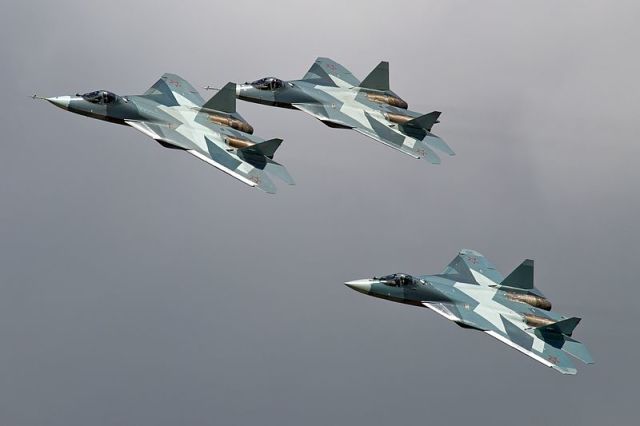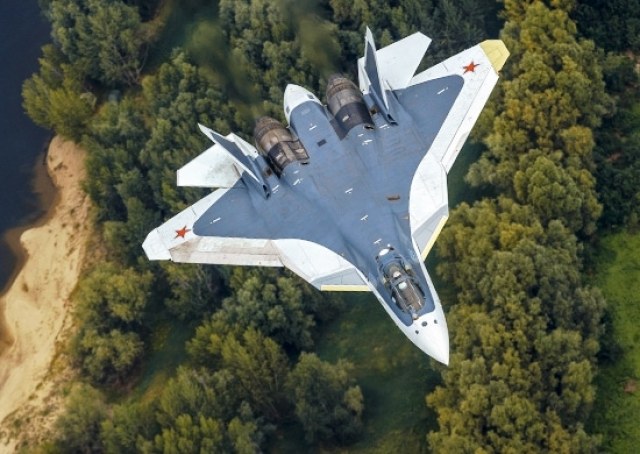Most likely, this is the first full-fledged use of a fundamentally new fighter for its intended purpose.
Russia has been using Su-57 aircraft in a special operation in Ukraine since March of this year, a source in the domestic military-industrial complex told TASS. However, the tactics of their use remains quite specific. As the agency notes, there is no official confirmation of this information.
The conflict can serve to "run-in" aircraft that began entering the Air Force only in 2020. Although the Su-57 was previously used to a limited extent in Syria, the aircraft was not officially in service with the Russian army at that time. In addition, it was not possible to use it as a fighter in Syria, and the Russian side has such an opportunity in combat operations on Ukrainian territory, and its fighters periodically shoot down enemy aircraft.
According to a TASS source, in the current conflict, the Su-57 "operate outside the zone of active destruction by enemy air defense means, using missile weapons." Although the main part of the Ukrainian air defense launchers has already been put out of action, there are enough remaining ones to use Russian aviation in modes atypical for the Air Force in the wars of recent decades.
Attack aircraft — attack aircraft and bombers — work there, as a rule, from extremely low altitudes, which prevents the enemy from detecting them. Fighters, accordingly, keep at considerable altitudes, but away from the territory occupied by the opponent, so as not to be hit by his air defense missiles.
Despite this, they retain the ability to hit enemy aircraft. The fact is that the range of air—to-air missiles in Russian fighters is quite high: for R-37M missiles (Su-57 carries six of these at once) it is more than 200 kilometers. Thus, the new aircraft is capable of carrying more missiles of such a serious range than any other modern fighter. The R-37M operates on the principle of "shot — forgot", that is, after the launch, the pilot may not follow it, but attack another target. Due to this set of qualities of his weapons, he can shoot down the enemy even if he himself remains at a considerable distance from the front line.

The Su-57 has been undergoing an intensive test flight program for many years, but it is used for the first time in the presence of enemy aircraft in the air
Image source: Wikimedia Commons
The peculiarity of the air conflict in Ukraine now is that it proceeds in a mode that has not been observed since at least the Yom Kippur War: both sides have serious air defenses. Even the noticeably weaker air defense of Ukraine still has S-300 installations, Buk early modifications and, in addition, a significant number of MANPADS.
As a result, judging by the video from the Russian Ministry of Defense, even attack aircraft (battlefield planes) often hit targets "over the horizon", firing unguided aircraft missiles from low altitudes, sharply lifting their noses (from the cab). This technique reduces the probability of defeat by the enemy, but also significantly reduces the accuracy of aviation weapons. In this regard, the conflict in Ukraine is being monitored by the Air Forces of almost all countries, trying to understand how it would be possible to actively use combat aircraft in conditions of at least a relatively equivalent enemy.
Probably, the use of the Su-57 is also connected with this: the army wants to gain experience in the combat use of a new fighter in such conditions. It should be noted that the Russian Air Force does not disclose which of their planes are shooting down enemy aircraft: for example, on May 2 and 6, the military department reported downed MiG-29 and Su-27 aircraft of the Ukrainian side, but did not indicate who shot them down and how. Theoretically, this may also mean that there are already downed cars on the account of the Su-57. There is no more accurate information on this issue in the public domain yet.
The Su-57 is capable of carrying up to eight air—to—air missiles (six of them are long-range), 70% of its surface is made of composite materials. In combination with the specific forms of the machine, this seriously reduces the overall radio visibility. Unlike the vast majority of combat aircraft in the world, it has a significant range on a featureless supersonic flight (up to 2000 kilometers even without additional tanks). Engines with a controlled thrust vector make the Su-57 extremely maneuverable, although it remains unclear how much this quality can be in demand in the war in the air these days.

